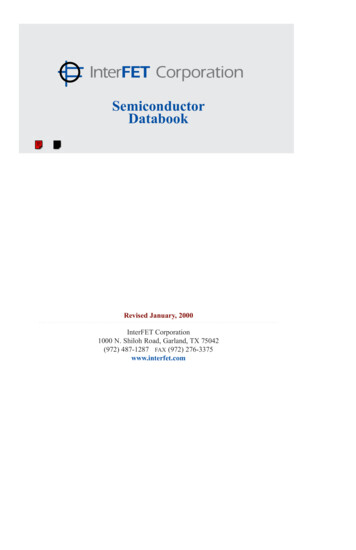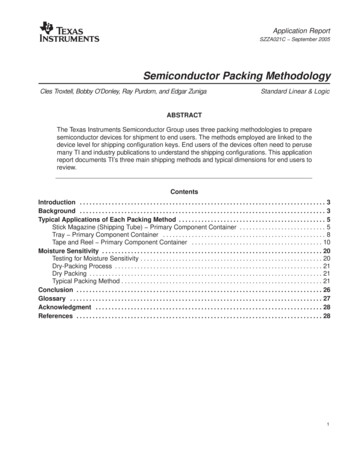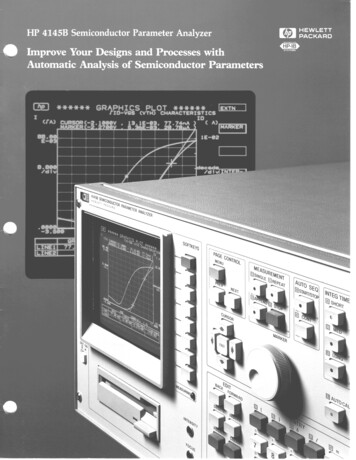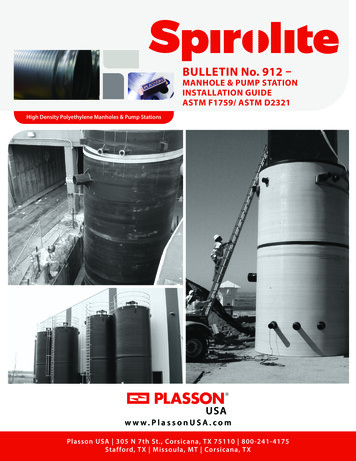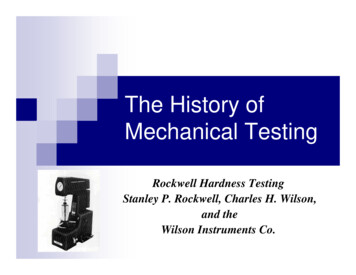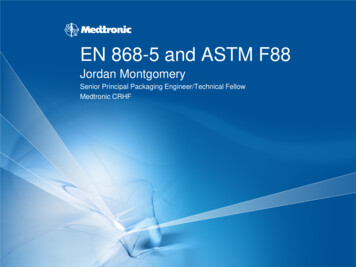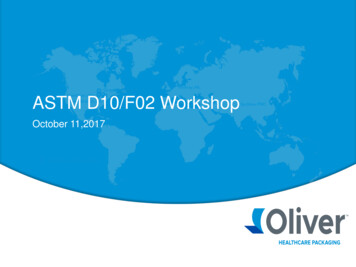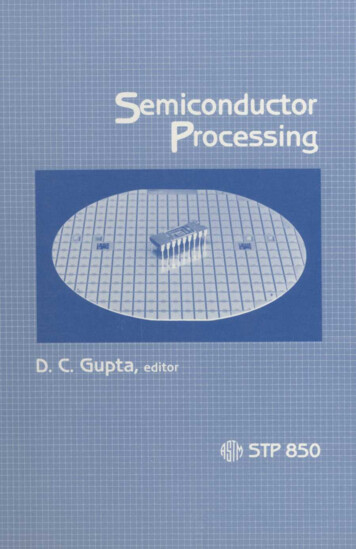
Transcription
SEMICONDUCTORPROCESSINGA symposiumsponsored by ASTMCommittee F-1 on Electronics,National Bureau of Standards,Semiconductor Equipment and Materials Institute,and Stanford University IC LaboratorySan Jose, CA, 7-10 Feb. 1984ASTM SPECIAL TECHNICAL PUBLICATION 850D. C. Gupta, Siliconix Inc., editorASTM Publication Code Number (PCN)04-850000-461916 Race Street, Philadelphia, PA 19103#
Library of Congress Cataloging in Publication DataSemiconductor processing.(ASTM special technical publications; 850)"ASTM publication code number (PCN) 04-850000-46."Includes bibliographies and index.1. Semiconductor industry—Congresses. I. Gupta,D. C. (Dinesh C.) II. ASTM Committee F-1 on Electronics.III. Series: ASTM special technical publication; 850.TK7871.85.S467 1984621.3815'284-18476ISBN 0-8031-0403-0Copyright by A M E R I C A N S O C I E T Y F O R T E S T I N G AND M A T E R I A L SLibrary of Congress Catalog Card Number: 84-18476NOTEThe Society is not responsible, as a body,for the statements and opinionsadvanced in this publication.Printed in Baltimore, MDOctober 19841984
ForewordThe Third Symposium on Semiconductor Processing washeld at San Jose, California on 7-10 February, 1984under the chairmanship of Dinesh C. Gupta, SiliconixIncorporated. It was sponsored by ASTM Committee F-1on Electronics and co-sponsored by the National Bureauof Standards, Semiconductor Equipment and MaterialsInstitute and Stanford University Integrated CircuitsLaboratory. The Technical Committee was headed byEdwardE.Gardner,IBMCorporationandtheArrangements and Publicity Committee by CarlA.Germane, Motorola Incorporated.The following persons participated in the AdvisoryBoard, and various Committees, namely; the TechnicalCommittee, the Arrangements and Publicity Committee,Registration Committee and the Spouse Committee: LisaAnderson,SEMI;Kenneth E.Benson, AT&T BellLaboratories; W.Murray Bullis, Siltec Corporation;Kathleen Bullis;Michael H. Christ, Dynamit ion;TerryA.Francis,AirProductsCorporation;Barbara Germano; Gilbert A. Gruber,Siliconix, Inc., Lou Ann Gruber; Vijay Gupta; HeinzHerzer, Wacker-Chemitronic, Philip L. Lively, ASTM;Robert D. Larrabee, National Bureau of Standards;Robert E. Lorenzini, Siltec Corporation; Samuel L.Marshall, Solid State Technology; Jan Meighan, SanJose Convention Bureau; James D. Meindl,StanfordUniversity; Eric Mendel, IBM Corpoation; J. TimothyRaab,Rockwell International;Robert I.Scace,National Bureau of Standards; Donald G. Schimmel, AT&TBell Laboratories; Fritz G. Vieweg-Gutberlet, ents.In addition, the guidance was provided by the Chairmenand the officers of ASTM Committee F-1 on Electronicsand its various subcommittees. The following personspresidedthetechnical andworkshopsessions:K.G.Barraclough, Royal Signals & Radar Establishment;K.E.Benson, AT&T Bell Laboratories; W.M.Bullis, SiltecCorporation; P.L.Castro, Hewlett-Packard Laboratories;M.I.Current, Trilogy Systems Corporation; P. Douglas,American Fine Wire Corporation;C.A. Germano,Motorola,Inc.,G.G.Harman,National Bureau ofStandards; H. Herzer,Wacker-Chemitronic;P. H.Langer,AT&T Bell Laboratories;R. D. Larrabee,National Bureau of Standards; B. J. Masters, IBMCorporation; J.H.Matlock, SEH America Inc., A. R.Neureuther, University of California, Berkeley;A.Rapa, IBM Corporation; W. R. Schevey, Allied Chemical
Corporation; G.R.Srinivasan, IBM Corporation; B.Stone,Monsanto Company & C.J.Varker, Motorola Incorporated.We are specially indebted to WilliamCavanaugh,President of ASTM,for an impressive talk on "TheRole of ASTM in the Electronics Industry", SheldonWeinig, Chairman, Materials Research Corporation and amember of the President's Advisory Council on PrivateSector Initiatives who presented a dinner speech on"Competitive IC Market: Will Automation and TechnologyImprovements Offset the Rising Costs of Manufacturingand Equipment", and to the members of the panel uctorResearch Cooperative andDirector,National Science Foundation;Richard Fair,VicePresident, Microelectronics Center of North Carolina;Angel Jordan, Provost, Carnegie-Mellon University;James Meindl, Director, Stanford Center for IntegratedSystems; and William Oldham, Professor, University ofCalifornia, Berkeley. The panel was moderated by Dr.Angel G. Jordan.We are grateful to the members and the guests of ASTMCommittee F-1 and SEMI who were called upon from timeto time for special assignments during the two-yearplanning of the Symposium.Over one hundred and forty persons participated in thereview process for the papers published in lication would not have been possible. And finally,we acknowledge the hard work and efforts of the staffof publication, review and editorial departments ofASTM in bringing out this book.
A Note of Appreciationto ReviewersThe quality of the papers that appear in this pubHcation reflects not onlythe obvious efforts of the authors but also the unheralded, though essential,work of the reviewers. On behalf of ASTM we acknowledge with appreciationtheir dedication to high professional standards and their sacrifice of time andeffort.ASTM Committee on Publications
RelatedASTM PublicationsSilicon Processing, STP 804 (1983), 04-804000-46Lifetime Factors in Silicon, STP 712 (1980), 04-712000-46Laser-Induced Damage in Optical Materials: 1982, STP 847 (1984),04-847000-46Laser-Induced Damage in Optical Materials: 1981, STP 799 (1983),04-799000-46
PrefaceThe papers in this volume were presented at the ThirdSymposium on Semiconductor Processing held in SanJose, California on 7-10 February 1984. The symposiumwas sponsored by ASTM Committee F-1 on Electronics,and co-sonsored by National Bureau of Standards,Semiconductor Equipment & MaterialsInstitute andStanford University Integrated Circuits Laboratory. Inaddition to the technical presentations, the cussions; impressions of these workshops and paneldiscussions are provided in appendices I-III.The symposium addressed new problems in semiconductortechnology for the mid 80's which arise from the rapidincreasesin device complexity ip,automated factories,and silicon foundries.Therealization of acceptable yields and reliability g discipline from starting materials tofinished devices. The symposium theme was chosen to beQuality Through Measurement and Control.The symposium opened with the talks on the role ofASTMin the electronics industry by William T.Cavanaugh, ASTM, and the impact of standards onsemiconductor quality and manufacturing efficiency ons were followed by two keynote papers, oneon the process and device modeling for VLSI structuresby James D.Plummer, Stanford University and the otheron the equipment requirements for the VLSI productionby Wilmer R. Bottoms, Varian Associates. Both thesepapers described techniques and equipments needed toachieve the required functional yields in complexdevices on an integrated circuit chip.The opening general session included a discussion onthe Cooperative Research among industry, academia andgovernment. Brief summaries of activities at theSemiconductor Research Cooperative, MicroelectronicsCenterof North Carolina,Stanford CenterforIntegrated Systems and the University of California atBerkeley were presented. A synopsis of the paneldiscussion in response to key questions from theaudience is presented in appendix I.Many other forums including the Fifth InternationalConference on Neutron Transmutation Doping and the
CHMTchapterSymposium.ofIEEEdecidedtomeetwiththeThe response to the symposium was extremely favorableonce again. The involvement of industry, academia andgovernment including the participation of foreigninstitutions confirmed a continued need for a regularforum to discuss technology topics in the context ofmeasurement and control; a consistent theme which ing and control of the complex processtechnologies required for VLSI and other advanceddevice concepts.The plans for the next symposium in 1986 in the seriesof symposia to be held at two-year intervals areunderway. The problem areas and standardization needsidentified in these symposia will provide the feedbackto the research community and voluntary standardssystemessential for the future growth oftheindustry.The cooperation and support of the ASTM staff in theformulationof these proceedings is appreciated.Finally, we are indebted to our industrial, governmentand university colleagues who contributed to thecontents of the Symposium and the Proceedings.San Jose, California.Dinesh C. Gupta
ContentsIntroductionSTANDARDS IN SEMICONDUCTOR INDUSTRYThe Impact of Standards on Semiconductor Quality andManufacturing Efficiency—w. MURRAY BULLIS9FABRICATION TECHNOLOGYProcess and Device Modeling for VLSI Structures—JAMES D . PLUMMER21Effect of Process Conditions on Autodoping in Silicon Epitaxy—HSUEH-RONG CHANG38An Intrinsic Gettering Process to Improve Minority Carrier Lifetimesin MOS and Bipolar Silicon Epitaxial Technology—JOHN O. B O R L A N D , MAX K U O , JAMES SHIBLEY,BRUCE ROBERTS, ROLAND SCHINDLER, A N D TERRY DALRYMPLE49Control of Gain Variations in Shallow Junction Ion ImplantedBipolar Transistors Caused by Planar Channelling—DAVID J. BAZLEY63Ion Implantation for Deep [ 100 m] Buried Layers—WOLFGANG R. FAHRNER, DIETER B R A U N I G , M E I N H A R D KNOLL,ANDJOACHIM R. LASCHINSKIA Study of Strain in Ion Implanted Silicon—MASAYOSHI77SASAKI ANDKOUICHI SAKAMOTO96Dry Etching Using NFj/Ar and NFs/He Plasmas—JOHN BARKANIC,ANDREW H O F F , JOSEPH STACH, A N D B O G D A N GOLJA110Edge-Controlled, Self-Consistent Proximity Effect Corrections—HARRY L. BERKOWITZ, CHARLES F . COOK, JR.,JOSEPH H. KWIATKOWSKI, A N D WAYNE M. GOODREAU124
The Effect of Wafer Flatness on Yield by Off-line ComputerSimulation of the Photolithographic Process—LOUIS DENES143CONTROL OF PARTICULATE CONTAMINATIONForms of Contamination Affecting Device Processing—ANGELO C. RAPA163Problems Associated with Submicrometre ContaminantMeasurement—ALVIN LIEBERMANPoint-of-Use Ultrafiltration of Deionized Rinse Water and Effects onMicroelectronics Device Quality—PETER W. GAUDET172184DEFECTS AND GETTERING TECHNIQUESThe Effects of Wafer Thermal History on the 450 C Thermal DonorFormation in Cz-Grown P(IOO) Silicon—JOHN OGAWA BORLAND201Interaction Between Point Defects and Oxygen in Silicon—JOSEPH R. MONKOWSKI, DANIEL HECK, THOMAS A. BAGINKSI,DAVID K E N N E Y , A N D RICHARD E . TRESSLER219Effects of Oxygen on Process-Induced Defects and Gettering inCz-Silicon—ROBERT B. SWAROOP230Precipitation Behavior of Deposited Metals in Cz-Silicon—HISAAKI SUGA, YASUSHI SHIMANUKI, KOJI MURAI, ANDKAZUYOSHI ENDO241Evaluation of Gettering Efficiency of Backside Damage by the Use ofthe "Haze" Test—MARCELLO DOMENICI,GIANCARLO FERRERO, A N D PAOLO MALINVERNI257Extrinsic Gettering Via the Controlled Introduction of MisfitDislocations—ALI S. M. SALIH, HYEONG J. KIM,ROBERT F . D A V I S , A N D GEORGE A. ROZGONYI272The Effect of Si-SiOj Interface on the Excess Point DefectDistribution in Silicon—YUN-SEUNG SHIN AND CHOONG-KI KIM 283
MATERIAL AND PROCESS CHARACTERIZATIONFracture Tracing in Semiconductor Wafers—LAWRENCE D. DYER297A Preferential Etch for Silicon Crystals—K. H. YANG309Oxygen Determination in Silicon Using Fourier Transform InfraredSpectroscopy—L. W. SHIVE AND B. K. SCHULTE320A Study of the Spatial Distribution of the Oxygen Content in SiliconWafers Using an Infrared Transmission Microscope—K R I S H N A S W A M Y K R I S H N A N A N D DONALD KUEHLInfluence of Electrically Active Impurities on IR Measurements ofInterstitial Oxygen in Silicon—s. p. WEEKS325335The Effects of Instrumental Artifacts on the QuantitativeDetermination of Oxygen in Silicon by FTIR—ASLAN BAGHDADI343Simultaneous Determination of the Boron and Phosphorus Content inSilicate Glasses by FTIR Spectroscopy—KRISHNASWAMY KRISHNAN358A Method to Determine the Initial Phosphorus and BoronConcentrations in Float-Zoned Polysilicon Rods—HERNG-DER CHIOU364The Effects of RF Electromagnetic Radiation on SpreadingResistance Measurements—ROBERT G. MAZURDopant Profiling in Silicon—MAREK PAWLIK375390Comparison of Depth Profiling of '"B in Silicon Using SpreadingResistance Profiling, Secondary Ion Mass Spectrometry, andNeutron Depth Profiling—JAMES R. EHRSTEIN,R. GREGORY DOWNING, BRIAN R. STALLARD, DAVID S. SIMONS,AND RONALD F. FLEMING409INTERCONNECTION TECHNOLOGY: WIRE AND TAPE BONDINGThe Ball Bond Shear Test: Its Methodology and Application—H A R R Y K . CHARLES, JR., GUY V. C L A T T E R B A U G H , ANDJOEL A. WEINER429
The Annealing and Low Temperature Aging Characteristics of FineDiameter Wire Produced from Dilute Aluminum Alloys—DAVID F . HEBERT458Capacitive Microphone Tuning of Ultrasonic/ThermosonicBonders—WILLIAM L. LOOFBOURROW472A Comparative Study of the Mechanical Properties of BondingWire—s. P . HANNULA, I. WANAGEL, AND C. Y. LI485New Applications of Tape Bonding for High Lead Count Devices—JAMES F . MARSHALL AND ROBERT P . SHEPPARDBumped Tape Processing and Application—FRANKA. LINDBERG500512NEUTRON TRANSMUTATION DOPING TECHNIQUES AND FACILITIESProduction and Development of Neutron Transmutation DopedSilicon—HEINZ H E R Z E R533Production of Detector-Grade Silicon by Neutron TransmutationDoping—WILFRIED VON AMMON AND J. KEMMER546Neutron Transmutation Doping in Hydrogenated AmorphousS i l i c o n — H . HAMANAKA, K. KURIYAMA, M. YAHAGI,K. I W A M U R A , C . KIM, F . SHIRAISHI, K. TSUJI, ANDS. MINOMURA558Effects of Hydrogen on Defects in Neutron Irradiated Silicon—YONGCHANG DU, YUFENG ZHANG, AND XIANGTI MENG566Neutron Transmutation Doping of Semi-Insulating Czochr
sponsored by ASTM Committee F-1 on Electronics, National Bureau of Standards, Semiconductor Equipment and Materials Institute, and Stanford University IC Laboratory San Jose, CA, 7-10 Feb. 1984 ASTM SPECIAL TECHNICAL PUBLICATION 850 D. C. Gupta, Siliconix Inc., editor ASTM Publication Code Number (PCN) 04-850000-46 #

